Along the way, we stopped for dinner at Cracker Barrel, since Sarah had never been there before and it seems to be a southern institution. The biscuits and gravy were yummy but the chicken and dumplings had an odd and unexpected slimy consistency. How unfortunate!
We arrived at Skidaway Island after dark (which, granted, is early these days), set up camp, and fell asleep to the sound of fireworks in the distance. We’d seen that Savannah has fireworks on the first Friday of the month, but given that we didn’t know when or where they were, we hadn’t bothered to drive into town to find them.
The next morning dawned bright and chilly. Sarah went for a jog along the park trails while Brian hung out at the campsite. The trail took her by a marsh with an observation tower, some old liquor stills, earthen works, and a strange-looking group that was apparently making a movie. At least, that was Sarah’s best guess as to why someone was dressed in a fuzzy bear costume, along with a bed and full living room (including rug, love seat, and TV) set up along the trail. It was rather strange.
After breakfast, we went into Savannah for the rest of the day. Sarah had been to Savannah once in college, but this was Brian’s first time there.
Savannah is a charming city, with an easily walkable historic downtown punctuated frequently by 21 city-block-sized squares in the center of town. Refreshingly, most of the historic section was free of omnipresent chain restaurants and touristy shops. The few shops and markets that did cater to tourists were clustered around River Street rather than spreading out to mar the entire historic district.
As we started our walk, we were drawn to a busy-looking square just north of the visitors center. It turned out that the Telfair Museum of Art was having its annual art festival. A wide assortment of work from local artists was on display, ranging from photos and paintings to thought-provoking multimedia collages.
From Telfair Square, we continued along to Bull Street, which boasts a square every few blocks and a large park at the end. The squares are lovely to stroll around. Most are shaded by stately live oaks draped with Spanish moss and surrounded by historic homes.
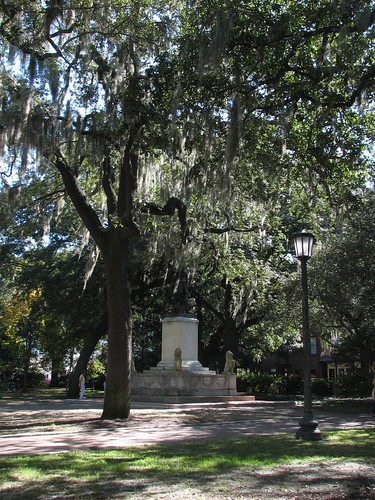
Most of the squares’ centers contained monuments, many of which honored American Revolution heroes, Civil War heroes, and other prominent figures from Savannah’s early history.
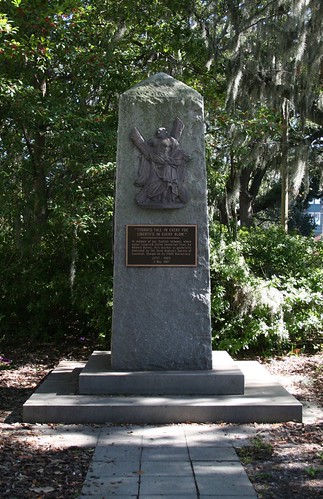
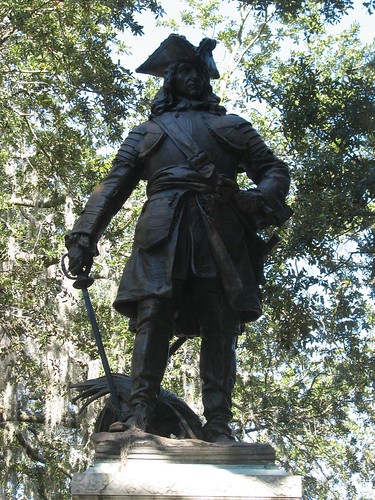
We also passed some historic buildings, including the Independent Presbyterian Church.
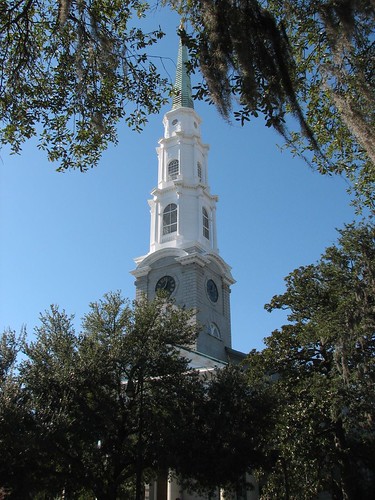
This building had interesting writing on the side, though we aren’t sure what it was.
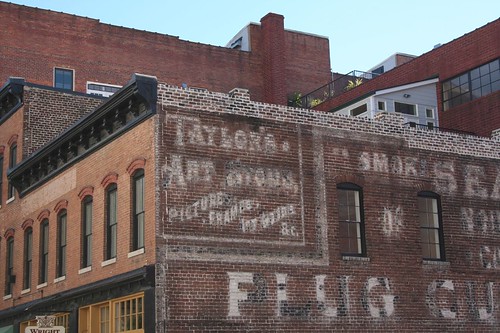
Continuing along, we saw more monuments, moss-shaded streets, and well-preserved historic buildings.
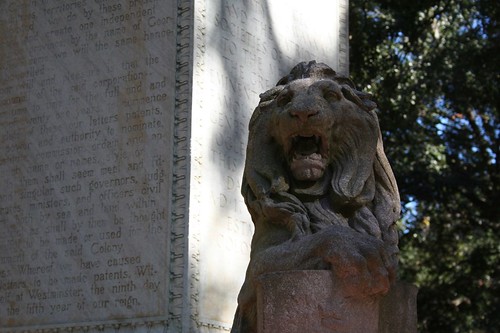

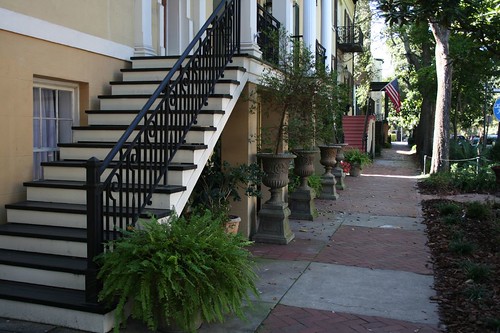
Monterey Square boasted another large monument.

At the end of Bull Street, we finally reached Forsyth Park. The highlight of the park is a large fountain.
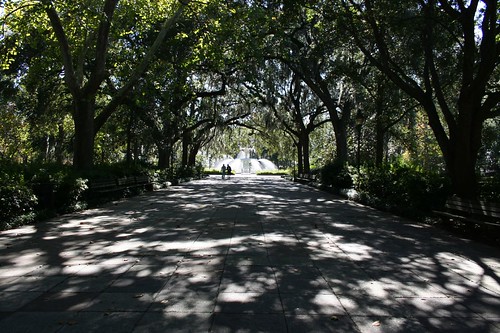
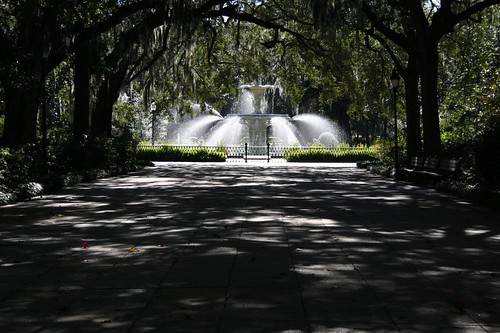
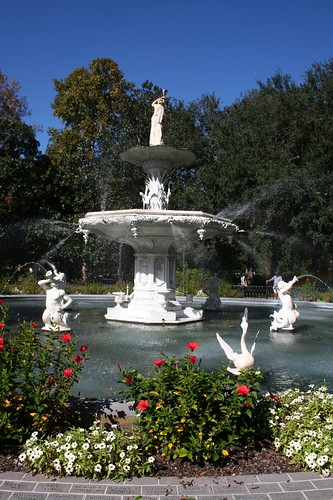

Given that it was a sunny Saturday afternoon, the park was full of people – there was a soccer game, a kid’s birthday party, and numerous people just out for a walk. It’s nice that Savannah has so much open space right in the city.
From Forsyth Park, we walked along historic Gaston Street.
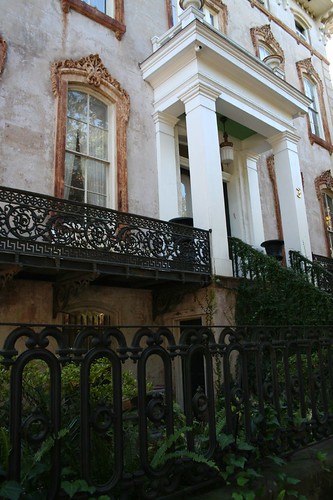
Then we proceeded north towards the river along Abercorn Street. Abercorn Street had nearly as many squares as Bull Street. The highlight, though, was the Colonial Park Cemetery, which contained graves from as early as the 1700s.
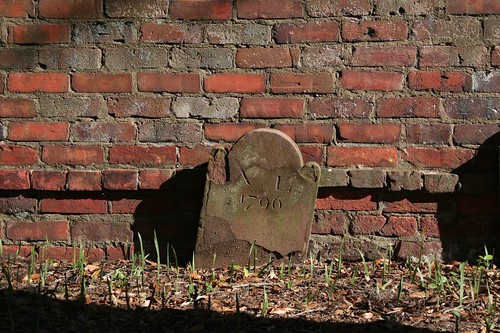
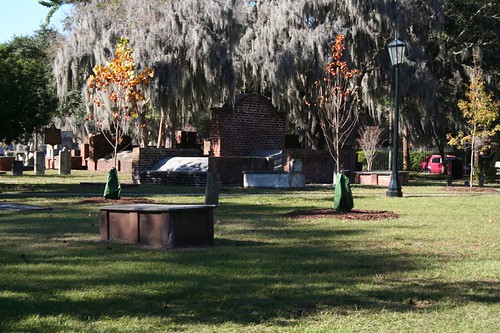
By this point, we were tired from all the walking and lack of food, so we sat under a tree in the cemetery and had a snack to refuel.
Next we stopped briefly at the Owens-Thomas House. This is one of the well known historic homes that offer tours. We decided there was enough else to see in town that we’d pass on the tour, so we just took a photo of the outside of the building.

Eventually, we made our way to River Street, which, not surprisingly, runs along the Savannah River. The street has a collection of fun and funky touristy shops and a small market. Our favorite place was River Street Sweets. We’ve seen more than our share of fudge shops throughout our travels, but this one had all the others beat. To start with, there was an abundance of hot pralines (and, of course, free samples). Yum!
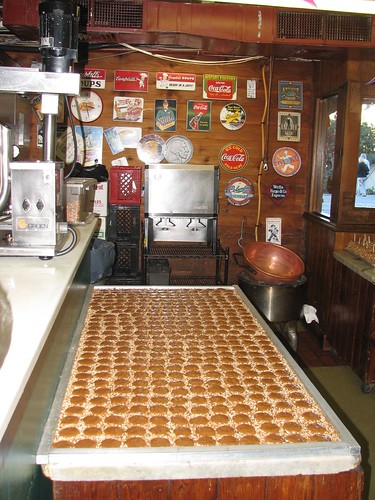
They were making their own taffy with this odd-looking contraption that pulled the taffy, wrapped it, and spit it out the bottom. From there, it was funneled into a cart and pulley system that delivered it to barrels in another part of the store.
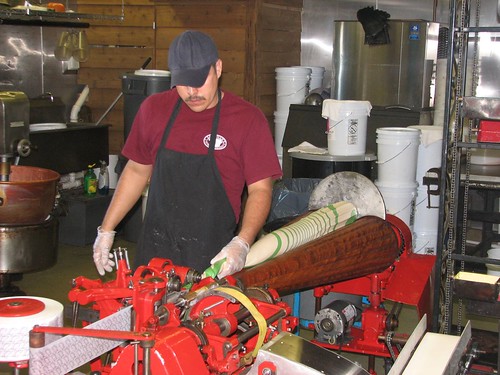
We found a number of other delectable-looking homemade goodies and barrel upon barrel of vintage candies.
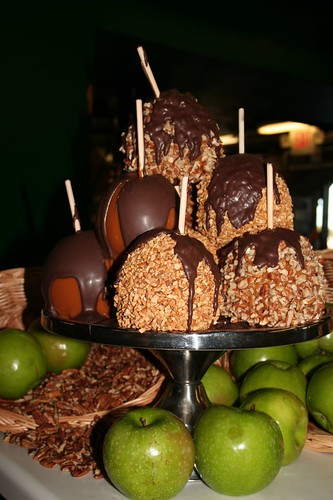


Back outside, a street performer entertained people and a trolley tour passed by on the cobblestone streets.


Further down the street, past most of the bustle, we took a break at a tavern offering cheap happy hour specials. From there, we walked through City Market and eventually back to our car, which was parked near the visitors center. We’d definitely gotten our exercise for the day.
Sunday, November 9, after our morning run, we drove out to Fort Pulaski. Fort Pulaski was built by order of James Madison after the war of 1812 as part of a coastal protection system. Before the fort was ever used to defend against foreigners, Georgia seceded from the union and the Civil War broke out. The Confederates took the fort without any resistance, which set the stage for a battle that would change military history.
One day, the Confederates saw Union troops positioning themselves on Tybee Island, a mile away from the fort – too far to mount an artillery attack, or so they thought. The union used a new type of cannon, however – a rifled cannon, which could shoot farther and more accurately than a traditional cannon, due to the addition of grooves on the inside. Worse, since the fort was U.S. property before the South took it, the Union troops had its blueprint, so they knew exactly which section of wall to target to give them access to the powder magazine on the northwest side of the fort, where 40,000 pounds of gunpowder was stored. Once the Union cannons blasted through the wall and started lobbing cannonballs very close to the powder magazine, the Confederate commander surrendered, rather than wait till the powder magazine exploded and took the lives of all of his troops. With the fort in Union hands, the Savannah port was shut down for the rest of the war. And the innovation of rifled cannons had made forts all along the coast obsolete.
As it turns out, the fort was hosting a historical reenactment in honor of Veterans’ Day. There were a number of people who’d spent the weekend there dressed in period costume and giving weapons demonstrations. Here, the soldier on the right demonstrates proper form when using a bayonet while the soldier on the left calls out commands.

Death by bayonet seemed like a particularly gruesome way to go, but as it turns out, the most common use for a bayonet during the war was as a candle holder (pointed tip stuck in the ground, candle in the rounded end that attaches to the gun).
Next was a demo of a firearm of the time.

The big finale was the demo of the cannons.
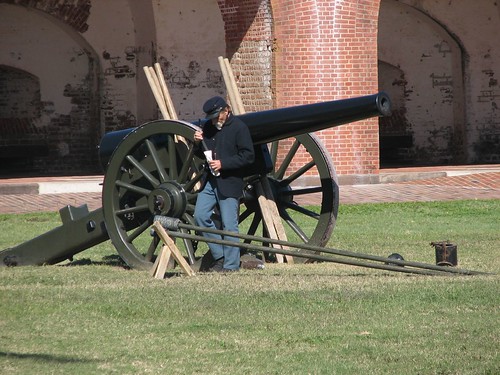
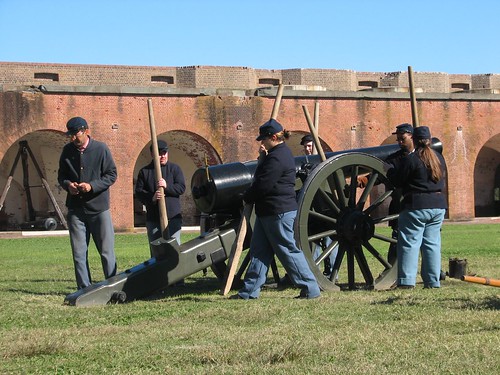
Here the crew demonstrates how these large weapons were moved into place using long poles.
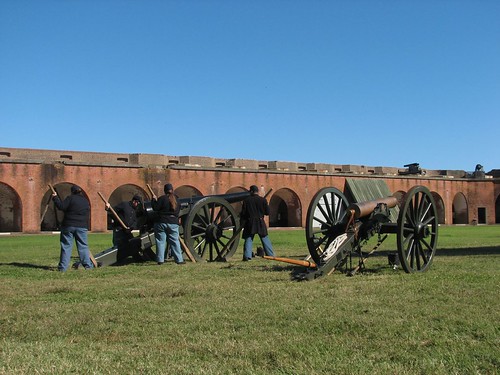
The blast from the canon was earsplitting, even though they used only half as much gunpowder as would have been used in war.

Here, the entire group of soldiers is assembled to tell the crowd about themselves. The women who’d come along to cook for the weekend looked on.

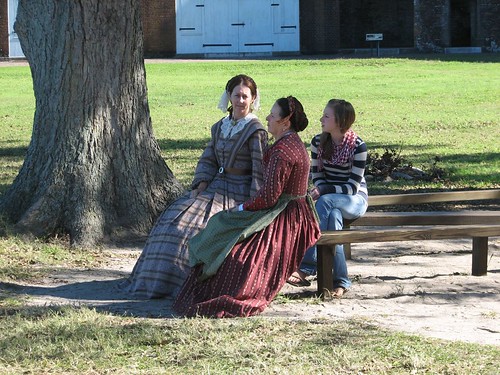
After the demonstrations, we wandered around the rest of the fort. This cannon is pointed out toward the entranceway of the fort.
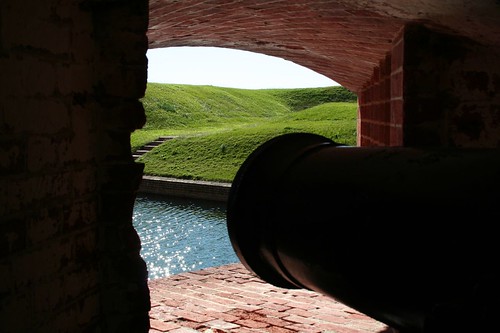
From the top of the fort, there was a clear view of the marsh and river beyond it.
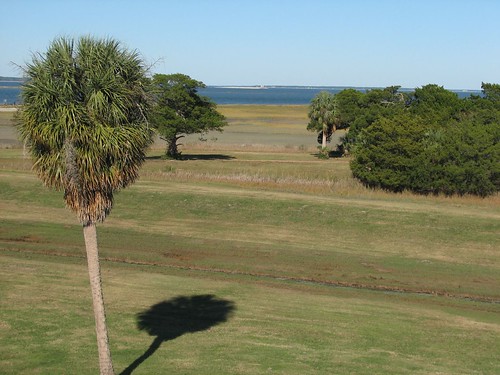
Here’s the view looking back towards the courtyard of the fort.
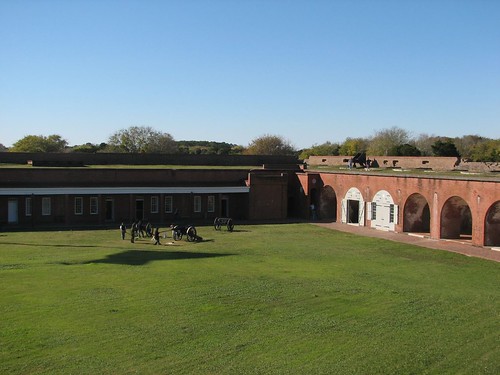
Outside the fort, much of the damage was still visible, including some cannonballs that were still lodged in the walls. The lighter brick is an area where the entire wall was rebuilt.
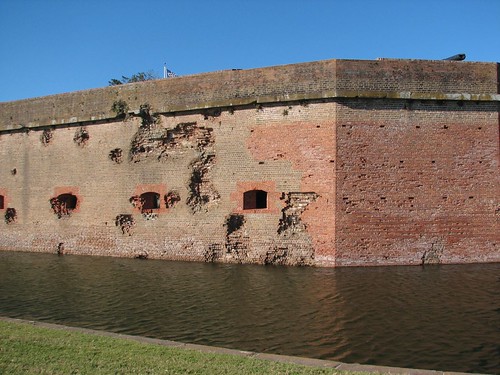
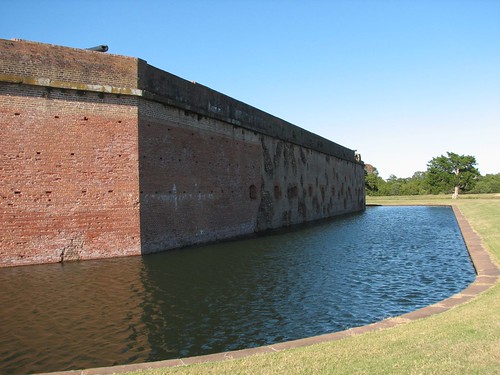
After our visit to the fort, we drove out to Tybee Island. A large public beach there is apparently very popular with locals, though in the off-season, it was looking quite uninspiring. A bunch of construction was going on, and the part of the beach that wasn’t blocked off had an enormous pipe running across it.
After the full day of sight-seeing, we went back to Skidaway Island for one more night before continuing up the coast to Charleston, South Carolina.
1 comment:
I hope you enjoyed our great state of Georgia. Fort Pulaski is one of my more memorable adventrues.
Post a Comment